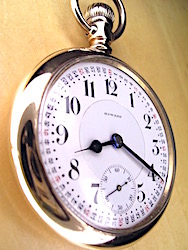 1912 E.Howard 16 size
1912 E.Howard 16 size
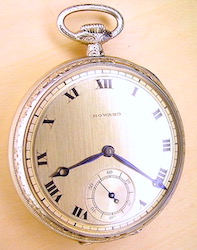 1917 Howard 12 size
1917 Howard 12 size
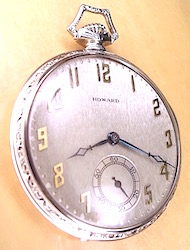 1919 Howard 12 size
1919 Howard 12 size
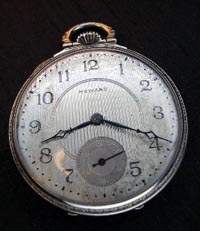 12 size Howard pocket watch
12 size Howard pocket watch
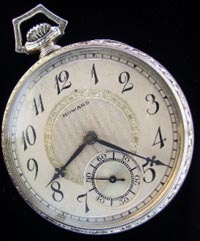 12 size open face Howard pocket watch
12 size open face Howard pocket watch
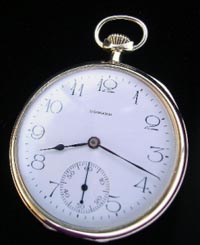 14 size Howard pocket watch
14 size Howard pocket watch
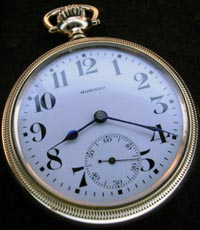 16 size Howard lever set pocket watch
16 size Howard lever set pocket watch
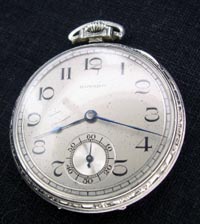 Howard 10 size open face pocket watch
Howard 10 size open face pocket watch
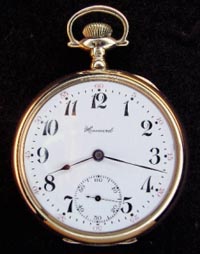 Howard 14 size open face pocket watch
Howard 14 size open face pocket watch
 Howard 14 size open face pocket watch
Howard 14 size open face pocket watch
 Howard 16 size open face railroad grade
Howard 16 size open face railroad grade
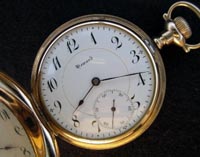 Howard hunters
Howard hunters
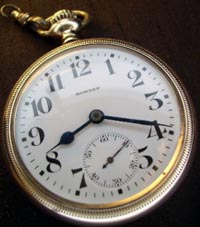 Howard open face railroad pocket watch
Howard open face railroad pocket watch
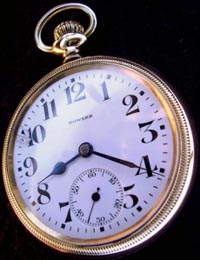 Howard railroad pocket watch 16 size
Howard railroad pocket watch 16 size
 Howard railroad pocket watch 16 size
Howard railroad pocket watch 16 size
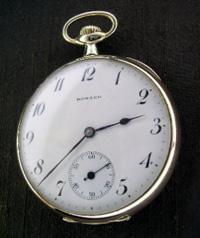 12 Size Howard open face p.w.
12 Size Howard open face p.w.
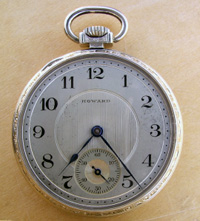 14 size open face Howard pocket watch
14 size open face Howard pocket watch
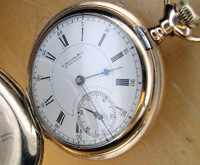 16 size Howard hunters pocket watch
16 size Howard hunters pocket watch
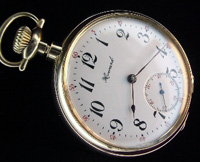 16 size Howard pocket watch open faced in solid gold case
16 size Howard pocket watch open faced in solid gold case
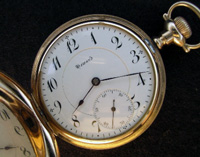 Howard open faced 16 size pocket watch
Howard open faced 16 size pocket watch
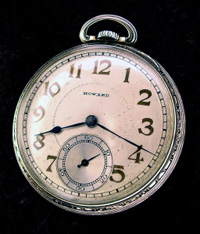 Howard 12 size open face pocket watch
Howard 12 size open face pocket watch
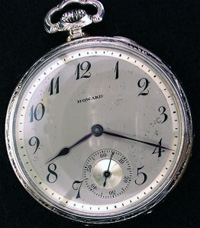 Open face solid gold Howard pocket watch
Open face solid gold Howard pocket watch
Howard Pocket Watch Repair
Contact Us Winding / Setting TestimonialsContact Terry at watchrepair.cc
"Received the Howard yesterday. I'm sure my Grandfather would be very happy to know his Howard is once again "like new". When the watch was broken (we don't speak of how this happened so I don't know this part) it was like wrecking the family car which affected everyone.
I don't believe I will need to inform other members of my family but some harmony will
be restored to their lives on an unconscious level because of your work. Many thanks!"
Howard watch company like so many other early American
manufactures, picked up where other previous commercial
attempts failed. Early manufacturing, certainly of high-grade
and critical instruments weren't for the faint of heart. Electric
powered machinery wasn't yet invented. Mass production
was still a vision. Sustainable monetary support couldn't
be counted on. These were the conditions that the Boston
Watch company were challenged by, as the first American
maker of quality timepieces beginning their venture in it's
first incarnation in 1852. Production and financial difficulties
forced Mr. E. Howard a Boston Watch co. director, to depart
the company which gave birth to his company and his vision
- E.Howard & Co. In 45 years of ground breaking design and
manufacturing, the E. Howard company made 123,700 pocket
watches and was also known as a maker of fine clocks, even
those of substantial size for public use.
Over the next 45 years, The E. Howard watch company, it's remaining movements, it's
name and designs were purchased and re-sold to number of
American watch factories. In short, the E. Howard watches
were original, in unique sizes, and revolutionary technology.
When later sold, these watches were made and known as
"Keystone Howard" pocket watches. Still made in America,
still of a very high quality, yet made by the successors of the
original company. If you own an original E. Howard pocket
watch or a later Howard pocket watch, this page is dedicated
to these exquisite timepieces and their guaranteed repair.
Please continue reading more about these epic instruments
and when you choose to learn more about my guaranteed
and exacting Howard pocket watch repair services, please
review my following pocket watch repair page:
https://www.watchrepair.cc/pocketwatches.html

Howard Pocket Watch Serial Numbers / Dates:
"Received the Howard yesterday. I'm sure my Grandfather would be very happy to know his Howard is once again "like new". When the watch was broken (we don't speak of how this happened so I don't know this part) it was like wrecking the family car which affected everyone. I don't believe I will need to inform other members of my family but some harmony will be restored to their lives on an unconscious level because of your work. Many thanks!"
Howard watch company like so many other early American manufactures, picked up where other previous commercial attempts failed. Early manufacturing, certainly of high-grade and critical instruments weren't for the faint of heart. Electric powered machinery wasn't yet invented. Mass production was still a vision. Sustainable monetary support couldn't be counted on. These were the conditions that the Boston Watch company were challenged by, as the first American maker of quality timepieces beginning their venture in it's first incarnation in 1852. Production and financial difficulties forced Mr. E. Howard a Boston Watch co. director, to depart the company which gave birth to his company and his vision - E.Howard & Co. In 45 years of ground breaking design and manufacturing, the E. Howard company made 123,700 pocket watches and was also known as a maker of fine clocks, even those of substantial size for public use. Over the next 45 years, The E. Howard watch company, it's remaining movements, it's name and designs were purchased and re-sold to number of American watch factories. In short, the E. Howard watches were original, in unique sizes, and revolutionary technology. When later sold, these watches were made and known as "Keystone Howard" pocket watches. Still made in America, still of a very high quality, yet made by the successors of the original company. If you own an original E. Howard pocket watch or a later Howard pocket watch, this page is dedicated to these exquisite timepieces and their guaranteed repair. Please continue reading more about these epic instruments and when you choose to learn more about my guaranteed and exacting Howard pocket watch repair services, please review my following pocket watch repair page: https://www.watchrepair.cc/pocketwatches.html

Howard Pocket Watch Serial Numbers / Dates:
| 1858 | 2000 | 1873 | 130,000 | 1888 | 530,000 | 1859 | 2500 | 1874 | 175,000 |
| 1889 | 570,000 | 1860 | 3000 | 1875 | 200,000 | 1890 | 600,000 | 1861 | 30,000 |
| 1876 | 220,000 | 1891 | 620,000 | 1862 | 35,000 | 1877 | 240,000 | 1892 | 640,000 |
| 1863 | 40,000 | 1878 | 260,000 | 1893 | 660,000 | 1864 | 45,000 | 1879 | 280,000 |
| 1894 | 680,000 | 1865 | 50,000 | 1880 | 300,000 | 1895 | 700,000 | 1866 | 55,000 |
| 1881 | 325,000 | 1896 | 725,000 | 1867 | 60,000 | 1882 | 350,000 | 1897 | 750,000 |
| 1868 | 65,000 | 1883 | 374,000 | 1898 | 775,000 | 1869 | 70,000 | 1884 | 400,000 |
| 1899 | 800,000 | 1870 | 73,000 | 1885 | 430,000 | 1900 | 812,000 | 1871 | 77,000 |
| 1886 | 475,000 | 1901 | 825,000 | 1872 | 100,000 | 1887 | 500000 | 1902 | 840,000 |
| 1903 | 854,000 |
| Year | Serial No | Series | No Produced |
|---|---|---|---|
| 1858 - 1860 | 113 - 1900 | I (18S) | 1,800 |
| 1860 - 1861 | 1,901 - 3,000 | II (18S) | 1,200 |
| 1861 - 1862 | 3,001 - 3,100 | K (14S) | 100 |
| 1861 - 1863 | 3,301 - 3,400 | See Notes* | See Notes* |
| 1861 - 1863 | 3,301 3,400 | III (18S) | 100 |
| 1861 - 1863 | 3,401 - 3,500 | i (10S) | 100 |
| 1861 - 1871 | 3,501 - 28,000 | III (18S) | 24,500 |
| 1868 - 1883 | 30,001 - 50,000 | IV (18S) | 20,000 |
| 1869 - 1899 | 50,001 - 71,500 | V (16S) | 21,500 |
| 1874 - 1878 | 100,001 - 105,500 | VI (6S) | 5,500 |
| 1883 - 1899 | 200,001 - 227,000 | VII (18S) | 27,000 |
| 1893 - 1894 | 228,001 - 321,000 | VII (18S) | 3,000 |
| 1884 - 1899 | 300,001 - 309,000 | VIII (18S) | 9,000 |
| 1895 - 1903 | 309,001 - 310,000 | VIII (18S) | 1,000 |
| 1890 - 1895 | 400,001 - 405,000 | IX (18S) | 5,000 |
| 1892 - 1899 | 500,001 - 501,500 | X (12S) | 1,500 |
| 1895 - 1903 | 600,001 - 601,500 | XI (16S) | 1,500 |
| 1896 - 1904 | 700,001 - 705,500 | XII (16S) | 1,500 |
| Notes: Reserved for experimentals. | |||
As with many pocket watch manufacturers, in 1902 the Howard Pocket Watch name was transferred to the Keystone Watch Case Co. Keystone then produced complete (movement and case) Howard watches from 1902. below is a list of expected serial numbers to cover the Keystone ownership period.
|
1902 - 850,000 1903 - 900,000 1909 - 980,000 1912 - 1,100,000 |
1915 - 1,285,000 1917 - 1,340,000 1921 - 1,400,000 1930 - 1,500,000 |
E. Howard & Company Boston (Roxbury) Mass. (1858-1903) Appearing on the movements of these watches you'll find a small engraving of an animal - either a deer, a horse or a hound which will designate the internal refinement of these brilliant timepieces. The Deer being the highest quality the Horse being mid-quality and the hound picking up the rear. Regardless of these designation, any E. Howard pocket watch was made to the highest standards.
E. Howard N size pocket watch models (near 18 size) E. Howard & Co. appearing on the dial and movement is Model 1857, Series I models, Series II model, Series III model, Series IV model, Series VII models, Series VII models, Series VIII models, Series IX models, Series VII models, Series VIII models, I model (Isochronism model),
E. Howard L size pocket watch models (near 16 size) Model V, model XI, model XII, model XII in 21 jewel.
E. Howard K size pocket watch models (near 14 size) - Model K, key wind 18k E. Howard J size pocket watch models (near 12 size) - Series X stem wind o.f. E. Howard I size pocket watch models (near 10 size) - Series I, key wind hunter E. Howard G size pocket watch models (near 6 size) - Series VI, in 15 jewel
E. HOWARD / HOWARD / E. HOWARD WATCH CO. BOSTON, U.S.A. (1903-1930) ... otherwise known as the Keystone Howard watches, these also had an image engraved on the plates of it's movements of an arrow with a circle in the middle of it's shaft. In this circle was either a Maltese cross (23 jewel), a star ( 21 jewel) a triangle (19 jewel) or a void in this circle (17 jewel). These were fine watches with the premium model being the Edward Howard chronometer which sold for $350 in 1912. The average wage in 1912 was .22 cents an hour. Keystone Howard watches weren't produced in 18 size and were limited to only three sizes:
16 size Keystone Howard pocket watch models: Series O in 23 jewel, Number 1 in 21 jewel, Series 1 in 21 jewel, series 2 in 17 jewel, Series 3, Number 5 in 19 jewel, Series 5 in 19 jewel, the 1905 model in 17 jewel, Series 9 in 17 jewel, Series 10 in 21 jewel, Series 11 railroad chronometer with 23 blue sapphire jewels in an 18k case. View Movements »
12 size Keystone Howard pocket watch models: Series 6 in 19 jewel, open and hunters case, Series 7 in 17 jewel, Series 8 in 23 jewel open face and hunters case gold filled. View Movements »
10 size Keystone Howard pocket watch models: Thin model in 21 jewel, Thin model in 19 jewel and the thin model in 17 jewel. Nearly all of these watches are housed in solid gold cases. Many cases too are in octagon, hexagon, decagon, cushion and triad shaped cases. View Movements »
I've provided thousands of customers over the decades, high quality mechanical watch repair. I look forward to providing you guaranteed Howard pocket watch repair, Howard pocket watch restoration and service. Please visit my pocket watch repair page where I share the many details of this safe and warranted pocket watch repair services:
The formation of the E. Howard Watch company
Howard, Davis & Dennison, Roxbury, Mass 1850
American Horologe Company, Roxbury, Mass 1851
Warren Manufacturing Company, Roxbury, Mass 1851-53
Boston Watch Company Roxbury & Waltham Mass. 1853-57
Howard & Rice, Roxbury Mass 1857-58
E. Howard & Company, Roxbury 1858-1903
Keystone Watch Case Company, Jersey city, NJ 1903-30
In speaking of the manufacture of American watches, by machinery, it is often said that Mr. A.L. Dennison is the father of the industry. Within certain limits this honor can be accorded to him, but credit is also due to others and it is the writer's purpose, before going into details of the history of the company to define, if possible, the relations which each one bore to the enterprise as a whole. Certainly so far as the making of watches by machinery in America on the interchangeable plan was concerned. Mr. Dennison was it's father, but it must however, be borne in mind that the idea of machine made watches could not be called his entirely for ten years previous to this, an unsuccessful attempt was made in Hartford Conn., to make watches by machinery. While it brought about financial disaster to those interested, it resulted in the production of nearly or quite, one thousand watches.
Dr. Dennison was also the paternal ancestor of may distinctive feature in America watch manufacture which, in substance, remain the same today as when he introduced them. It may be further said that they will always remains as monuments of his thoughts and handiwork.
The Practical details of the business of the company, however were in large part left to Mr. Edward Howard, who was one of the proprietors. His indomitable will and mechanical skill were brought to bear on this point. The business management, which also rested o Mr. Howard's shoulders, was no small burden, as can be easily imagined by the following worlds of Mr. Dennison: "I do not think that there were seven time in the seven years that we were together that we had money enough pay all our employees at the time the wages were due. Very often we would find ourselves without any cash in hand, but Mr.Howard would manage in some way to produce enough to tied over with.
While speaking of Mr. Dennison, who was so prolific in ideas and so bold in schemes, and of Mr. Howard, who was both skillful and energetic, we must not forget to mention Mr. Samuel Curtis, the looking glass manufacturer of Boson, who had faith in the venture to the extent of furnishing $20,000 to carry on the business, although he never took an active part in it himself. He was, however as all must agree, a very important factor. The other gentleman interested was Mr. D.P. Davis, a partner of Mr. Howard in the clock business which was carried on independently of the watch factory. He never took any active part in the management of the latter. Before going further with the history of the enterprise we desire to give the short biographical sketch of the Mr. Dennison and Mr. Howard who were the two prominent gentlemen in it.
AARON L. DENNISON
Mr. Aaron L. Dennison was born in Freeport, Maine in 1812. His father removed to Topsham in 1818, and to Brunswick in 1814. Aaron, when quite young displayed a mechanical turn of mind, being very handy with his pocket knife. At the age of eighteen he was apprenticed to Jas.Cary, a clockmaker in the town, with whom he remained three year and went to Boston, where he offered his services free gratis to Messrs. Currier & Trott. This proved a good thing for the young man for he was with them a year and then took a window for himself near the corner of Washington and Milk Streets, but soon gave this up to enter the employ of Jubel Howe, who was in charge of the repair department of Jones, Low and Ball. From here he went to New York City and obtained a situation, and by some effort on his part, he was able to gain from Swiss and English workmen with whom he became acquainted a large amount of information about the various methods of doing fine work. In 1839 he decided to return to Boston and establish himself as a dealer in watches, tools and materials and do watch repairing for the side. He located at 116 Washington Street and issued catalogs to the trade. He kept his material in very orderly manner and to aid in this and in selecting new pieces readily he got out his "Standard Gauge",which has since become the U.S. Standard, especially for mainsprings. His experiences during these years may be considered a stepping stone to what he together with Hr.Howard, was able to accomplish a few years later. In 1845 Mr. Dennison engaged in a general jewelry business on the same street but his mind was still intent on a plan of establishing watchmaking on the well know system of interchangeability as practiced at Springfield Armory and among Connecticut clockmakers.
He visited the Armory and did a great deal of planning, often taking a walk late in the evening on the Common for that purpose. He went so far as to make a pasteboard model of the factory, having in view that the different departments should be connected by moving bands passing along in front of the workmen to transfer the work from one to the other. This writer is reminded in the connection of what a gentleman prominent as a watch manufacture said of him recently: "There is scarcely anything that could be thought of in the line of watch manufacture but what had been in Mr. Dennison's prolific brain at some time of another." He knew Mr. Howard of "Howard & Davis" and held several consultations with him in reference to his plans. Mr. Howard readily consented to join him if they could raise the necessary capital, but as Mr. Howard had no surplus to spare from his clock and scale business, they had to bring in a capitalist in the person of Samuel Curtis, of whom we have just spoken.
EDWARD HOWARD:
Edward was born in Hingham, Mass. the 6th. day of October, 1813. He lived there until the age of sixteen and then went to Boston as a indentured apprentice to Aaron Willard, Jr. to learn the trade of clockmaker. The term of apprenticeship was five years, at the end of which time the young man entered the employ of Mr. Henry Plimpton, who was the successor for Benjamin Dearborn, the inventor and maker of Dearborn's Patent Balance. He remained with Mr Plympton six years, working on fine bank balances. (scales)
In 1843 he formed a partnership with David P. Davis and Luther Stephenson, the first being Stephenson, Howard and Davis. They were located in the Theatre Alley where they made a general line of balances together with some church and gallery clocks, regulators and Willard timepieces. At the end of two years, the team removed the business to Roxbury, where they built a factory and increased their facilities for making both clocks and scales.
A short time previous to this, Congress had passed a law determining the amount of postage on letters by their weight and the Post master General had advertised for proposals for 40,000 letter balances. Each party desiring to bid was obliged to furnish samples of the kind of balance they though would be answer the the purpose. Mr. Howard designed and made five different kinds and went in person with them to Washington where he met about one hundred other on the same errand, all having samples. After a thorough test the contract was awarded to Mr. Howard and was continued by him in connection with the clock business for twenty years or more.
Soon after obtaining the government contract for the balances, Mr. Howarddesigned a standard of weights, measures and balances to conform to the new standard which had been delivered to the States by the general government. He embraced the whole in the cabinet and presented it to the Legislature of Massachusetts for inspection which, proving satisfactory, resulted in an order to make on for every city, town and country in the State, 330 in number at a total cost of $50,000.
In a letter to Mr. W.H. Keith, one of the former Presidents of the Waltham Watch Company, written to him by Mr. Howard, that writer finds the following with reference to what took place during those months. The first tool was for the purpose of forming the watch plates, with all their cuts and cavities at one movement. The tool was in the form of an upright lathe. The next tool consisted of a set of dies and punches whereby all the holes could be punched out at one time. It was supposed that ll the holes in all the plates, if they could be punched at all, would be alike and in the same place every time, bus such did not prove to be the case.
They were of course anxious to have these tools a success in order to begin the work at once and made only a few trial, pronounced the experiments a success and laid the tools aside for future use. Mr. Dennison was assisted in this work by Mr. O.B. Marsh, then in the employ of Howard & Davis. In the summer of 1850 several tools were completed and a model watch was made and other matters attended to. A move was also made towards securing location on which a factory was to be erected. A lot was purchased of Mr. Aaron D. Williams who owned much of the land in the vicinity. A building was erected on the corner of East and Prescott now Hampden St. nearly opposite the clock factory. The plot of ground upon which the building was erected was 50 by 125 feet. The building was 100 ft. long and 13 ft. wide, in the wings and 40 fee wide in the center. It was built of brick, two stories high: it was commenced in September 1850 and was completed in a later part of December of the same far, when it was immediately occupied. The power was a small steam engine. It now forms a part of the E. Howard Watch & Clock company's watch factory having since been raised to three stories and large additions made at different times. It was decided to conduct this new business at the start under the name of American Horologe Company.
The supposition to the reader would be that the firm was "Dennison, Howard & Davis" from the fact that so many of the watches are engraved with that trade mark. Such a firm, however, never existed. In reality is was a trademark which they used. "American Horologe company" was continued but a few months, it being too suggestive, as they were obligated to send across the water for much of the material they used, and the dealers on the other side were not entirely free from jealousy at the time. The name of the company was changed toWarren Manufacturing Company after General Joseph Warren who was born in Roxbury near the site of the factory in 1741, and who was killed at the battle of Bunker Hill in 1775. The first hundred watches which they made were engraved "Warren Company".
The first 100 movements were engraved, "Warren Company" and the remaining nine hundred which they made during their stay in Roxbury, were engraved "Samuel Curtis. While work was going on in the factory at Roxbury, Mr. Dennison had not been at rest in other directions. He claimed that the factory was not well located for the successful manufacture of watches. Mr. Dennison, in speaking of it, says - "Our location in Roxbury was not satisfactory. It was clay and pit-holes or rocky land and was even then too high priced for the greater portion of our employees to buy and build houses on . It was also very dusty in the summer for the work in the factory". Mr. Dennison looked at various locations and consulted with Mr. Howard. The most desirable spot seem to be at Stony Brook, a short distance above Waltham. But before locating there, the Bemis farm at Waltham comprising 106 acres was brought to the attention of Mr. Dennison who visited Waltham and called Mr. W.H. Keith, who had previously lived on the farm. He explained to Mr. Keith what they wanted - a good location where a considerable tract of land could be obtained and divided into lots to be disposed of to the employees for homes. Mr. Keith thought favorably of the project. This farm, however had then recently been sold to Mr. James Brown of the publishing house of Little, Brown of Bostonbut when the project was laid before Mr. Brown he consented to sell it for a $5,000 advance. This was on the 1st. of December 1853. Through the kindness of Mr. Keith the writer was able to make the following extract from a letter to him by Mr. Dennison a few days previous. Mr. Dennison wrote: " From what I know of our want and the disposition of the other member of our company, I have no doubt that we shall be albeit take hold of the said farm. I would suggest for your consideration to settle upon the sum of $100,000 as the capital stock of the company, and divide in into one hundred shares of $1,000 each." The result was the stock was all taken up by sixty persons within ten days after the issue of the circular, the Boston Watch Company taking $30,000 of the stock. The farm was purchased for $27,500 and the notes given for the bonus of $5,000 which Mr. Brown required.
The company then had about one hundred employees and were preparing to push their business vigorously. at least so far as their means would permit. The company were struggling to make ten watches per day, but it was more frequently that six only were produced and very often at the end of the month, it was found that not more than one hundred had actually been completed and put on the market. Everything now went along fairly smooth way after the removal to Waltham Mass, and the company kept making improvements to the real-estate. The sales had dropped off, to quite an extent owing to the dull times proceeding the financial and economic "panic" which was soon to sweep over the entire country, in the fall of 1856 Mr. Howard took charge of the manufacture of the watches and Mr. Dennison went out among the trade to establish if possible , some new agencies among retailers. He was to some extent successful. But times grew worse and worse and the Watch Company found themselves unable to meet their obligations.
Mr. Keith in speaking of Mr. Howard and Mr. Dennison said; "Both of these gentlemen are certainly worthy of the highest commendation, in that they assisted or unassisted, put forward measure to accomplish, with or without the principles and practices being know to them, which had been employed by Eli Whitney and subsequently produce a the Arsenal at Springfield Mass., and by the clockmakers of Connecticut and applied the same to the manufacture of watches, and produce goods that are a credit to themselves and acceptable to the public and the trade." Mr. Howard, in speaking to the writer of the division of honors between Mr. Dennison and himself, put the matter in a nutshell when he said; " One could not have accomplished it without the other. Mr. Dennison never could have made watches without me, and I never would have attempted to make watches without Mr. Dennison. Portions of the C.S. Crossman 1885 manuscript named: Watch Making in America, publisher unknown.

|
Contact terry@watchrepair.cc | ||
| Watch Repair Services Watch Case Repair Services For Wrist Watches For Pocket Watches Military Watches Chronograph Repair Services |
Mailing Instructions Shipping Instructions Contact WatchRepair.cc Home |
Everything Else Meet the Watchmaker How A Watch Works |
Copyright Notice © 1999-2022 Terry Nelson
All rights RESERVED. All material on this Website, including text, photographs, graphics, code and or software, are protected by international copyright and trademark laws. Unauthorized use is not permitted. You may not copy, modify, republish, reproduce, post, distribute or transmit material on this Web Site, in any manner.
www.watchrepair.cc
All rights RESERVED. All material on this Website, including text, photographs, graphics, code and or software, are protected by international copyright and trademark laws. Unauthorized use is not permitted. You may not copy, modify, republish, reproduce, post, distribute or transmit material on this Web Site, in any manner.
www.watchrepair.cc






